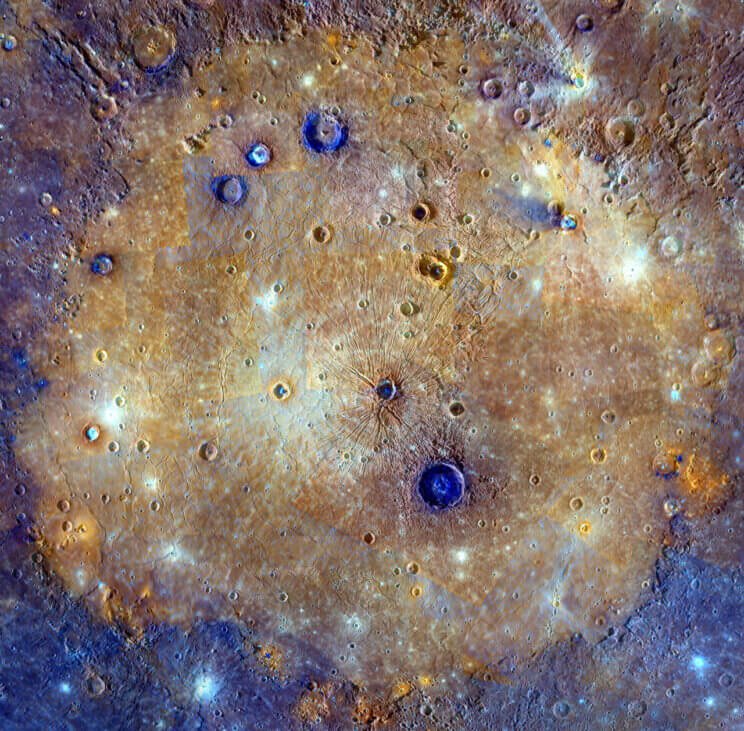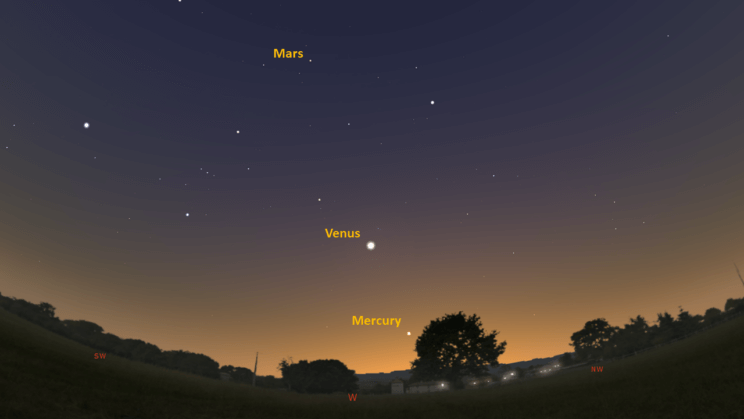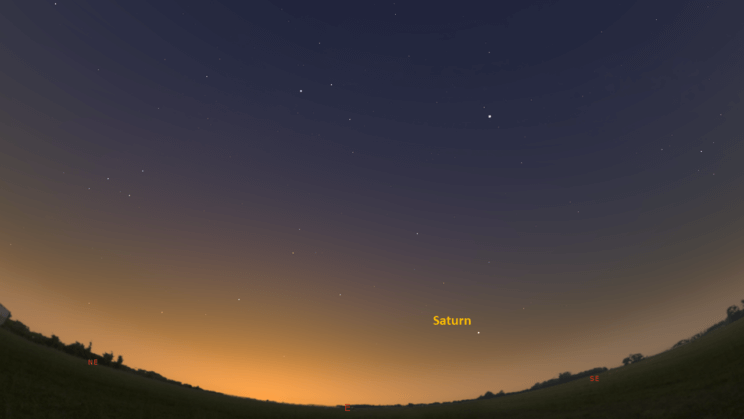This is the Saint Louis Science Center’s NIGHT SKY UPDATE for the week of Friday, April 7, 2023.
Information updated weekly or as needed.
Times given as local St. Louis time which is Central Daylight Time (CDT). For definitions of terminology used in the night sky update, click the highlighted text. If relying on times posted in Universal Time (UT), St. louis is -5 hours when CDT.
Public Telescope Viewings
As part of the Saint Louis Science Center’s First Fridays, weather permitting, the St. Louis Astronomical Society and the Science Center will set up a number of telescopes outdoors and be on-hand to answer your questions. Telescope viewing begins once it is dark. Regardless of the weather on May 5, join us indoors in our planetarium theater for “The Sky Tonight”. Showtime is at 7 p.m.
Observing Highlight of the Week

The Caloris Basin is a large impact site on the planet Mercury, It is approximately 960 miles across. This impact site is larger than the state of Texas. You can find the original image here. Image credit: NASA/Johns Hopkins University Applied Physics Laboratory/Carnegie Institution of Washington
This week offers us our best chance to see Mercury during its current apparition. To see Mercury this week you will want to look west about 30 minutes after sunset. A clear view of the western horizon will give you the best chance to spot the elusive planet. A few key points in Mercury’s orbit occur this week which is why it is our best opportunity to spot Mercury.
Evening apparitions of Mercury happen after Mercury reaches superior conjunction. This most recently happened for Mercury on March 17, 2023. Since this date, Mercury has slowly been climbing out of the Sun’s glare in the west. Like Venus, Mercury exhibits phases because Mercury is closer to Sun than Earth is. Both planets exhibit gibbous, quarter and crescent phases. Before and after superior conjunction is when they exhibit gibbous phases which is when Mercury is brightest. To see a phased Mercury, you will need to use a telescope.
During an evening apparition, Mercury transitions from gibbous to crescent after it reaches dichotomy. Dichotomy is when a planetary body is seen half-illuminated by the Sun. For its current apparition, Mercury reaches dichotomy on April 8, 2023.
A few days later, Mercury reaches greatest elongation on April 11, 2023. Elongation is an angular measurement of which Mercury will appear roughly 19° elongated from the Sun. After greatest elongation, Mercury will appear to head back towards the Sun. As a rule of thumb, I generally consider anything below 10° above the horizon to be too low due to trees and buildings. Mercury will remain above that 10° mark until April 20, 2023. After this date Mercury will become increasingly difficult to spot.
This apparition ends as Mercury nears inferior conjunction. This happens on May 1, 2023. If you miss spotting Mercury this month, it has several more apparitions this year. The next one starts in May, but you will have to be up before sunrise to spot the planet. Unfortunately, the next morning apparition is not great.
The Sun and Moon

The Moon as seen from the International Space Station, on July 31, 2011.
Credit: NASA
Sunrise is at 6:37 a.m. on Friday, April 7 and sunset is at 7:30 p.m. providing us with roughly 13 hours of daylight. Even after sunset, light from the Sun will dimly illuminate our sky for roughly 1 hour and 30 minutes. This period is called twilight, which ends around 9:03 p.m. this week. For those with a sundial, local noon occurs around 1:02 p.m. this week.
| Day | Sunrise | Sunset | ||||||||||
|---|---|---|---|---|---|---|---|---|---|---|---|---|
| 7-Apr | 6:37 a.m. | 7:30 p.m. | ||||||||||
| 8-Apr | 6:35 a.m. | 7:31 p.m. | ||||||||||
| 9-Apr | 6:34 a.m. | 7:32 p.m. | ||||||||||
| 10-Apr | 6:32 a.m. | 7:33 p.m. | ||||||||||
| 11-Apr | 6:31 a.m. | 7:33 p.m. | ||||||||||
| 12-Apr | 6:29 a.m. | 7:34 p.m. | ||||||||||
| 13-Apr | 6:28 a.m. | 7:35 p.m. | ||||||||||
| 14-Apr | 6:26 a.m. | 7:36 p.m. | ||||||||||
| 15-Apr | 6:25 a.m. | 7:37 p.m. |
Moon
Moonrise for Friday, April 7 is at 9:22 p.m. and moonset occurs at 7:50 a.m. on the following day. Friday, April 7, the Moon will exhibit a waning gibbous phase with 97% of the lunar disk illuminated. Last quarter moon occurs on April 13, 2023, at 4:11 a.m.
International Space Station (ISS) Observing

There are no visible passes of ISS from St. Louis for the week of April 7. There are however several morning passes of the Chinese space station named Tiangong. The best passes for this week are listed below. Use the table below for information about these passes.
Catch Tiangong from St. Louis starting Friday, April 7
| Date | Starts | Max. altitude | Ends | |||||||
|---|---|---|---|---|---|---|---|---|---|---|
| Time | Alt. | Az. | Time | Alt. | Az. | Time | Alt. | Az. | ||
| 11 Apr | -2.2 | 5:11:30 | 42 | SW | 5:12:23 | 70 | SSE | 5:15:29 | 10 | ENE |
| 12 Apr | -1.8 | 5:43:32 | 13 | W | 5:46:11 | 58 | N | 5:49:15 | 10 | ENE |
| 13 Apr | -2.1 | 04:43:53 | 74 | NE | 04:43:53 | 74 | NE | 04:46:48 | 10 | ENE |
Magnitude (Mag): The Measure of brightness for a celestial object. The lower the value is, the brighter the object will be.
Altitude (Alt): The angle of a celestial object measured upwards from the observer’s horizon.
Azimuth (Az): The direction of a celestial object, measured clockwise from an observer’s location with north being 0°, east being 90°, south being 180° and west being 270°.
For information about ISS flyovers and other visible satellites, visit www.heavens-above.com
Detailed information regarding all unmanned exploration of our universe, missions past, present, and planned, can be found at Jet Propulsion Laboratories:
The Visible Planets

Looking west at 8:00 p.m. on April 8, 2023. Credit: Stellarium, EG

Looking East at 6:00 a.m. on April 9, 2023. Credit: Stellarium, EG
This week, four naked eye planets will be visible. Mercury, Venus and Mars are found in the west after sunset. Saturn is now visible in the east about 30 minutes before sunrise.
Mercury
Mercury is visible in the west about 30 minutes after sunset. Mercury will reach greatest eastern elongation on April 11, 2023. Mercury remains visible in the west after sunset through April 20, 2023. After this date it will become increasingly difficult to spot Mercury.
Venus
Venus is now well into its current evening apparition. Venus will be a bright target in the west after sunset until August 2023 when it approaches inferior conjunction. This week, look for Venus in the west about 20 minutes after sunset. Venus sets at 10:42 p.m.
Mars
Mars now rises before sunset, becoming visible once it is dark. Look for it high in the west about 30 minutes after sunset. Mars sets by 2:10 a.m.
Saturn
Saturn is slowly climbing out of the Sun’s glare about 30 minutes before sunrise. For many of us, Saturn may still be too low to spot due obstruction along the horizon. 30 minutes before sunrise, Saturn will appear roughly 10° above the horizon.
James S. McDonnell Planetarium
Night Sky Update: April 8 – 15, 2023






